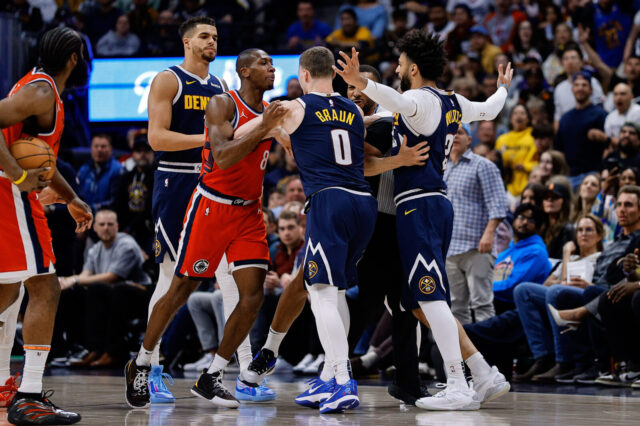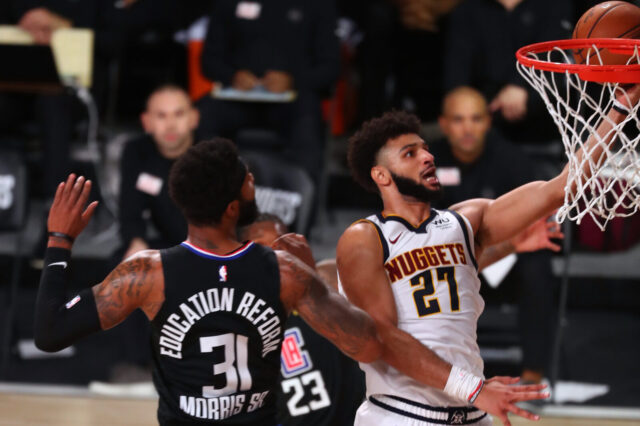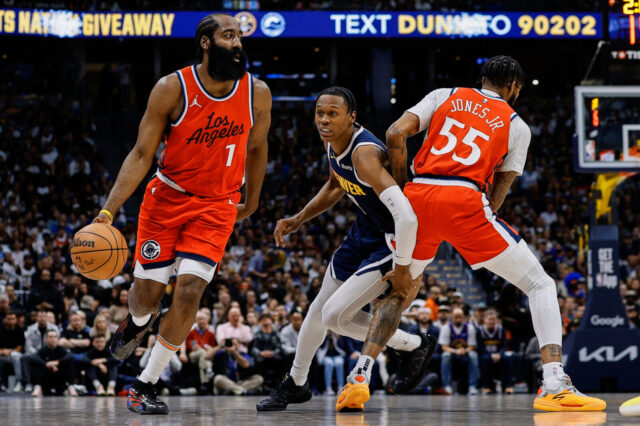The Denver Nuggets are in the midst of an offensive renaissance. They’ve won six of their last eight games behind great spacing, quick passing, and lights-out shooting. Some might call it Mile High Basketball, a throwback to the Doug Moe era of Nuggets basketball when teams flew into Denver knowing that they were in for a shootout regardless of what kind of defense they brought with them.
At the heart of Denver’s offensive revival is the decision by head coach Michael Malone to call fewer plays. After a practice on January 21st, Malone spoke with the media about his desire to recapture last year’s identity on the offensive end.
“I am calling way more play calls than I did in my first two years. We have gotten away from just playing the game. When you play the game you’re hard to guard because it’s not a play call that they can take away. It is…team’s didn’t know what the hell we were doing last year. We just played.”
The style of offense that Malone is referring to is read and react basketball and it was the style of play that helped lead the Nuggets to the best offense in basketball for the final four months of he season last year. Rather than scripting deliberate play calls like a pro football team, the Nuggets read and react to the flow of the offense, working both independently and collectively at the same time.
Let’s take a closer look at what read and react basketball looks like and how the Nuggets have managed to turn their offense around in this week’s spotlight.
This content is no longer available.
To understand read and react basketball, it’s helpful to first look at possessions that are the opposite of free flowing. Even over the last eight games, the Nuggets still go toward very deliberate actions to open quarters or when coming out of a timeout whenever want to get a specific shot for a specific player. The play below is an action that the Nuggets run quite frequently and provides a nice example of how set plays rely very heavily on execution but limit a team’s creativity and flexibility.
The first thing that pops out is just how long the action takes. There are just seven seconds left on the shot clock by the time Jamal Murray catches the ball at the top of the key. Secondly, notice how predictable this possession is. The viewers eyes are drawn to Jamal Murray because the entire action is based around his screens and cuts. Rewatch the play a second time but with an eye on Gary Harris. His role in this possession is to stand in the corner even after the possession gets bogged down. It’s a poor use of the team’s leading scorer and the action is so deliberate that none of the players deviate from the play’s design.
Over the last eight games, possessions like this have become less and less frequent. The team has replaced heavily-orchestrated actions with starting points and guiding principles that provide a launchpad for Denver’s creativity. The starting point below is a simple horns setup. Horns is the name for sets that start with a point guard up top, two “bigs” on each elbow, and shooters in each corner. The Nuggets are running a horns pindown play but the play is really just an initial action that gets the team and the ball moving. Everything that follows after the first five seconds is all about reading and reacting to the defense.
As Gary Harris comes off of the initial dribble handoff (DHO), the Oklahoma City Thunder do a great job of walling off the paint and taking away an easy look. In previous months, the Nuggets would then either spread the court and run pick and roll (PnR) or force a tough shot in isolation after their initial action got bogged down. Instead, Jokic and Harris quickly get right back into another super quick DHO and force the defense to make another read. The second time is a charm as the Thunder fall a half step behind the action. Once that micro-advantage is created, Jokic is able to read the court and choose the best of several good options, ultimately finishing with a Torrey Craig putback.
This is the key to the Nuggets allowing the offense to become less scripted; you unlock the creativity of Nikola Jokic. Remember that first video up above? Notice how Jokic is left standing at the top of the key trying to choose between three options. In the second video, Jokic’s options are virtually limitless after the initial action. That’s the biggest benefit of making the offense more free-flowing. As coach Malone says, “teams don’t know what they’re going to do” because rather than running a script, the team is reacting to the defense. It unlocks Jokic’s brain and the brains of all of the high IQ players on the roster.
Free flowing isn’t chaos
As much as it may look like chaos, the free flowing offense actually has a lot of structure to it. Players aren’t doing anything they want but rather choosing between two or three options, over and over and over again. Each decision that a Nuggets player makes sets up the next series of decisions for the other four Nuggets on the court.
To illustrate this, let’s start with a basic pindown DHO action. Below, Harris receives a pindown screen from Jamal Murray before running right into a DHO with Jokic. This specific example was a scripted offensive action but it works to illustrate one of the reads the team can make off of a basic setup. Side note: timing becomes increasingly important. Watch the clip a second time and notice how Wilson Chandler and Will Barton time their weakside action with the handoff, waiting for the right moment so that their defenders have to focus on the ball and on their own pindown screen.
In the scripted play above, Harris uses both the pindown screen and the DHO. In a free flowing offense, he actually has two other choices; he can use the first screen but then curl cut before the handoff or he can short cut the first screen.
This content is no longer available.
There are actually a few other decisions Harris could make out of this simple action. He could flip the script and back screen for Murray rather than receive the pindown or he could accept Murray’s screen but then set a ballscreen on Jokic. However, 99% of the time Harris will decide on one of these three options in this scenario. There are reads that can be made here on Harris’s part which can influence which option he choses. If the defense is switching the screen between him and Murray, he is more likely to short cut that first screen. If the defense jumps out early on the handoff, he is more likely to short cut the handoff. The variety of options keeps the defense honest.
Murray also has options in this scenario. He can “slip” the screen, meaning cut toward the hoop before Harris even makes his decision. This is another way to keep the defense on guard. Slips are useful when a team switches since it creates a cut at the exact moment when the defense is making the switch. Switches are also useful when Murray’s defender tries to step out and hedge the screen. Murray also has the option of using the DHO for himself, forgoing the pindown screen for Harris.
This content is no longer available.
So right off of the bat, a simple pindown DHO creates seven different reads that either Harris or Murray can make to give a different look. It seems a bit complex at first but with enough chemistry, the three players learn to just read and react to each other and the defense is left in a constant state of uncertainty about what the Nuggets might do next.
The pivot point of all of this is Nikola Jokic. He is the player who is put in position to make the most reads and he is also the player who is best equipped to make quick decisions, not just with the basketball but with when, where, and how to set screens or execute DHOs. For starters, Jokic is constantly surveying the court for the open man. These cuts that the wings are making create openings that last mere milliseconds and Jokic has to make the split second read for when to get rid of the ball.
Secondly, Jokic is constantly deciding whether to hold the ball for a stand still handoff, dribble into the DHO, or pitch the ball early and then run unto a PnR. That might sound like three similar things but it actually makes an enormous difference on how a team can and should defend the play. Jokic is incredible in how quickly he makes those decisions. Jokic might make five different decisions on five different plays. Sometimes it’s because he sees a weakness in the defense and favors one read over the other. Other times it’s simply to keep the defense guessing.
The timing and spacing of these DHOs is also something that can change every time down the court. If a defender tries to go under the pindown, Jokic might use his dribble to get below the three-point arc, placing the defender into a catch-22. Continue to go under the handoff and the wing can stop behind the handoff and get a catch and shoot three-pointer. Try to recover and go over the handoff and risk tailing the ball-handler into the paint. Over time, these micro-decisions add up and keep the defense from figuring out how to defend correctly. Every decision the defense makes provides an opportunity for the offense to react accordingly.
If that seems complex, consider for a moment how the above example only covers some of the option and reads there are between just three players on the strong side of the court in the first five seconds of a free flowing pindown DHO set. You can imagine how many more options open up when you swap, for example, Jokic and Murray. With Jokic as the pindown screener and Murray as the DHO guy, the defense begins to make different reads about how to defend this action and therefore the offense has even more options on how to react accordingly. Then there are the variety of options that each of the two weakside players have to make.
There’s also the team’s ability to roll directly from one action to another. For example, the Nuggets like to mix in pistol sets and double drag screen sets in transition. Those are completely different actions than the pindown DHO action highlighted above. However, all sets can flow directly into each other. The Nuggets can start a possession running pistol and flow perfectly into a pindown DHO without skipping a beat. The starting points are different but the principles of how to read the screens and cuts is largely the same.
That is the power of read and react basketball. It requires skilled, intelligent, and quick-thinking players at all five positions (as well as a lot of trust from the coaching staff and among the players themselves), but when teams are able to pull it off, the offense becomes unstoppable. Every defensive choice provides an opportunity for the offense to counter.
Golden State plays this style of basketball, as do the San Antonio Spurs. Both teams run different early offense, emphasize different things and take advantage of the different talents on their rosters but both teams rely on their players being able to read and react rather than simply move from point A to point B in deliberate, scripted movements.
Last season the Nuggets demonstrated that they too have the talent to play this way and over the last few weeks they’ve rediscovered their ability to play like this once again. Since the Nuggets have committed to playing more freely on January 21st, they have held the league’s best offensive rating (ORTG) despite playing against five of the league’s 10 best defenses over that span. They’ve hung 110 or more points on the Celtics, Warriors, Hornets, and Thunder while averaging 28 assists per game and shooting over 40% from behind the three-point arc. Not every team can play this style of basketball, but the Nuggets seem perfectly suited toward this type of structured chaos.
This content is no longer available.
Examples
As a footnote to the section above, here are just four examples of the team getting four different looks out of the same (or mostly the same) pindown DHO action. You can see how none of the examples set out to accomplish any one thing or get any specific look but by being unpredictable, the offense is able to stay one step ahead of the defense until a shot opens up.
Murray’s pocket passes in PnR
One other thing that has helped Denver’s offense over the last two weeks is the team’s ability to hit Jokic on rolls to the rim. This was something the team really struggled with for most of the year. Give Jamal Murray credit, he’s been excellent over the last few weeks as a decision maker in the pick and roll. Just watch how perfectly he’s delivering these passes through the outstretched arms of the defense.
Jokic playing possum
Another one of my favorite things that Jokic does is disguise his ball screens, especially in transition. Here, Jokic starts out by sprinting down the center of the floor, giving the appearance of a rim run inside the paint. However he makes an abrupt 90 degree turn toward the wing to set a transition screen for Harris, forcing Steven Adams into a switch. Adams is one of the best bigs in the league at preparing for PnR defense early but with well disguised screens, Adams’ preparedness works towards Jokic’s advantage. It became a game of possum, with Jokic luring Adams into jumping one direction and then completely changing the action before Adams can recover.
An accidental adjustment
“2 Down” has been a pet play for the Nuggets for several years now but they may have stumbled into a nice new counter that they can use in special circumstances. Nuggets fans recognize this set as the Jokic-to-Harris lob play. Harris gets an “Iverson screen” along the free throw line before curling toward the rim for the lob. At the same time, a wing (usually Wilson Chandler) cuts through the paint and either posts up on the right block or clears out to the corner.
Against the Warriors, Draymond Green did a great job of sitting on the Chandler post option while also clogging the paint. Steph Curry turned his head for a split second (seriously, watch how quickly Murray makes this read) and Murray sprints toward the basket for the easy dropoff. But one reason Murray gets so open is because Trey Lyles appears to set a back screen on this play. It’s a bit difficult to tell if it is more of an incidental bump than an actual screen. Either way, this wrinkle could be a nice option out of this set going forward. Most of the time it won’t produce such an easy shot at the rim but it still provides a pickle for the defense which will often result in a switch between Lyles’s and Murray’s defenders. That almost always results in a mismatch for both guys.
This content is no longer available.
4.8
That’s the number of fouls Nikola Jokic is drawing per game. Last season he drew just 3.2 per game. Jokic annoys defenders by getting tangled up on flex cuts, often to the chagrin of opposing fans and coaches alike. He’s got a weird rhythm on post-ups and dribble drives that lure defenders into reaching for the ball, mistaking Jokic’s slow feet for a slow mind. But Jokic is almost always ready for those reaches and swipes and uses a defender’s poor discipline against them.


